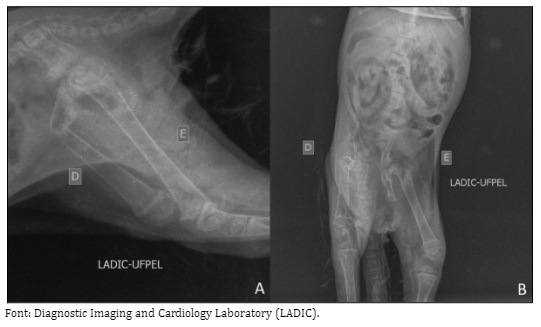Nutritional secondary hyperparathyroidism in a puppy Leopardus geoffroyi (d’Orbigny and Gervais, 1844)
DOI:
https://doi.org/10.21708/avb.2023.17.1.11068Abstract
Nutritional Secondary Hyperparathyroidism (NSH) is a metabolic disorder that mainly affects young animals. This disease causes imbalance between the levels of calcium and phosphorus, culminating in bone changes. Wild animals raised in captivity can develop the disease when they are given an inadequate diet. The aim of this study is to report the clinical findings, the complementary exams and the therapeutics utilized in a Leopardus geoffroyi (Geoffroy’s cat) cub originated from captivity. The animal went through complementary imaging exams and biochemical evaluation that respectively revealed generalized osteopenia and pathological fracture of the right femur, reduction of serum calcium level and elevation of serum phosphorus level. After diagnosis, a correction of the diet and mineral and vitamin supplementation was performed. The NSH diagnosis was stablished by associating history, clinical signs, imaging exams findings and serum biochemicals. The early identification of this disease is of paramount importance, because in this way corrections can be made in food management, in order to provide successful clinical recovery and promote quality of life for wild captive animals.
Downloads

Downloads
Pubblicato
Fascicolo
Sezione
Licenza
Copyright (c) 2023 Acta Veterinaria Brasilica

TQuesto lavoro è fornito con la licenza Creative Commons Attribuzione 4.0 Internazionale.
Autores que publicam na Acta Veterinaria Brasilica concordam com os seguintes termos: a) Autores mantém os direitos autorais e concedem à revista o direito de primeira publicação, com o trabalho simultaneamente licenciado sob a Licença Creative Commons Attribution que permite o compartilhamento do trabalho com reconhecimento da autoria e publicação inicial nesta revista. b) Autores têm autorização para assumir contratos adicionais separadamente, para distribuição não-exclusiva da versão do trabalho publicada nesta revista (ex.: publicar em repositório institucional ou como capítulo de livro), com reconhecimento de autoria e publicação inicial nesta revista. c) Autores têm permissão e são estimulados a publicar e distribuir seu trabalho online (ex.: em repositórios institucionais ou na sua página pessoal) a qualquer ponto antes ou durante o processo editorial, já que isso pode gerar alterações produtivas, bem como aumentar o impacto e a citação do trabalho publicado (Veja O Efeito do Acesso Livre).


 Esta obra está licenciada com uma Licença
Esta obra está licenciada com uma Licença 